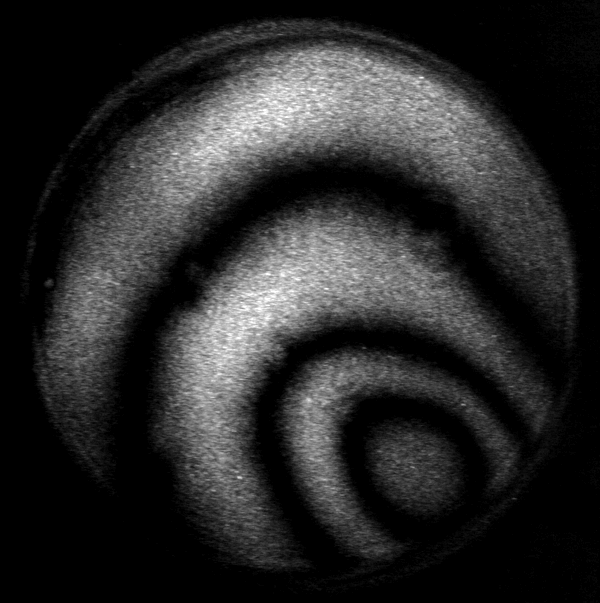
Del Mar Photonics - Adaptive optics (deformable mirrors) - Wavefront sensors - Complete adaptive optics system - Unimorph Deformable Mirrors part numbers
Example of Bimorp Deformable Mirror Response function measured with a Twyman-Green interferometer at l = 632.8 nm, 30 mm aperture.

Electrode #4 (outer ring): + 200V
Other examples: Defocus - Astigmatism - Coma - Arbitrary
Del Mar Photonics - Adaptive optics (deformable mirrors) - Wavefront sensors - Complete adaptive optics system - Unimorph Deformable Mirrors part numbers
Adaptive optics - deformable bimorph mirrors and wavefront sensors
Wavefront Sensors: ShaH Family
A family of ShaH wavefront sensors represents recent progress of Del Mar
Photonics in Shack-Hartmann-based technology. The performance of Shack-Hartmann
sensors greatly depends on the quality of the lenslet arrays used. Del Mar
Photonics. developed a proprietary process of lenslet manufacturing, ensuring
excellent quality of refractive lenslet arrays. The arrays can be AR coated on
both sides without interfering with the micro-lens surface accuracy. Another
advantage of the ShaH wavefront sensors is a highly optimized processing code.
This makes possible real-time processing of the sensor data at the rate
exceeding 1000 frames per second with a common PC. Due to utilizing low-level
programming of the video GPU, it is possible to output the wavefront data with a
resolution up to 512x512 pixels at a 500+ Hz frame rate. This mode is favorable
for controlling modern LCOS wavefront correctors.
The family of ShaH wavefront sensors includes several prototype models, starting
from low-cost ShaH-0620 suitable for teaching laboratory to a high-end
high-speed model, ShaH-03500. The latter utilizes a back-illuminated EM-gain CCD
sensor with cooling down to -100°C. This makes it possible to apply such a
wavefront sensor in astronomy, remote sensing, etc.
Specification Table for ShaH wavefront sensors:
| ShaH-0620 request a quote |
ShaH-03500 request a quote |
|
| Aperture dimension (diameter) [mm] | 6 | 3 |
| Number of subaperures for analysis | 1000 | 250 |
| Maximum tilt normal [rad] | ±0.05 | ±0.05 |
| Minimum measured curvature [m] | ±0.06 | ±0.03 |
| Repeatability RMS 2,3 | λ/100 | λ/100 |
| Absolute measurement accuracy RMS 2,3 | λ/25 | λ/25 |
| Relative measurement accuracy RMS 2,3 | λ/100 | λ/100 |
| Relative measurement accuracy P-V 1,2 | λ/20 | λ/20 |
| Tilt measurement sensitivity [rad] | 3E-6 | 5E-6 |
| Curvature measurement sensitivity [m] | 500 | 140 |
| Spatial resolution [mm] | 0.15 | 0.15 |
| Acquisition frequency [Hz] | 20 | 500 |
| Processing frequency [Hz] | 20 | 500 |
| Working wavelength [nm] | 400-1000 | 400-1000 |
| Calibrated waveband [nm] | 100nm | 100nm |
| Working temperature [0C] | +10 to +40 | 0 to +35 |
| Weight (max) [Kg] | 0.3 | 2 |
| Dimensions (LxHxW) | 155x55x55 | 258x174x139 |
Main features of the ShaH software:
Wavefront acquisition: Continuous or ext. trigger mode; absolute (factory
calibration) or referenced (user calibration) mode; background signal: save and
subtract in real time. The time history is only limited by the free memory
(approx. 50KB per frame). The stored data are available for retrospective
display, processing, and analysis.
Real-time functions and displays: Wavefront display (units: microns or waves):
3D plot; 2D projection; synthesized interferogram; Zernike polynomial
coefficients (up to 9th order); time history of 4 Zernike coefficients or
orders; RMS and PV phase error.
Point Spread Function measurement: PSF display: 3D plot; 2D projection.
Parameters: Strehl ratio; best focus plane; focal plane of ideal lens.
Retrospective functions and displays: All the functions available in real time,
plus:
Wavefront display: 3D plot, 2D projection, and XY profile without tilt and/or
focus and/or 3rd order aberrations; spot displacement map; residual zonal error
of modal approximation.
Pupil calculation: automatic or manual.
MTF display: 2D or 3D plot; XY profile; best focus plane; user specified plane;
focal plane of ideal lens.
Intensity display: 3D plot; 2D projection; XY profile; M² factor; intensity
profile at given distance
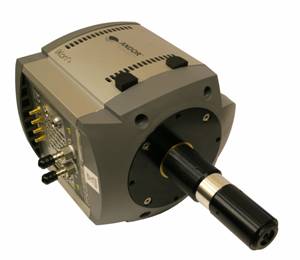 ShaH-03500 high-speed wavefront sensor
|
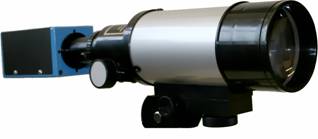 ShaH-0620
wavefront sensor with telescope |
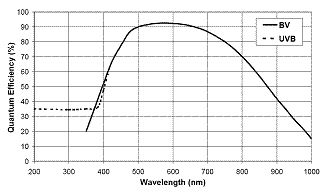
Quantum Efficiency (QE) spectral curve for ShaH-03500 high-speed wavefront sensor
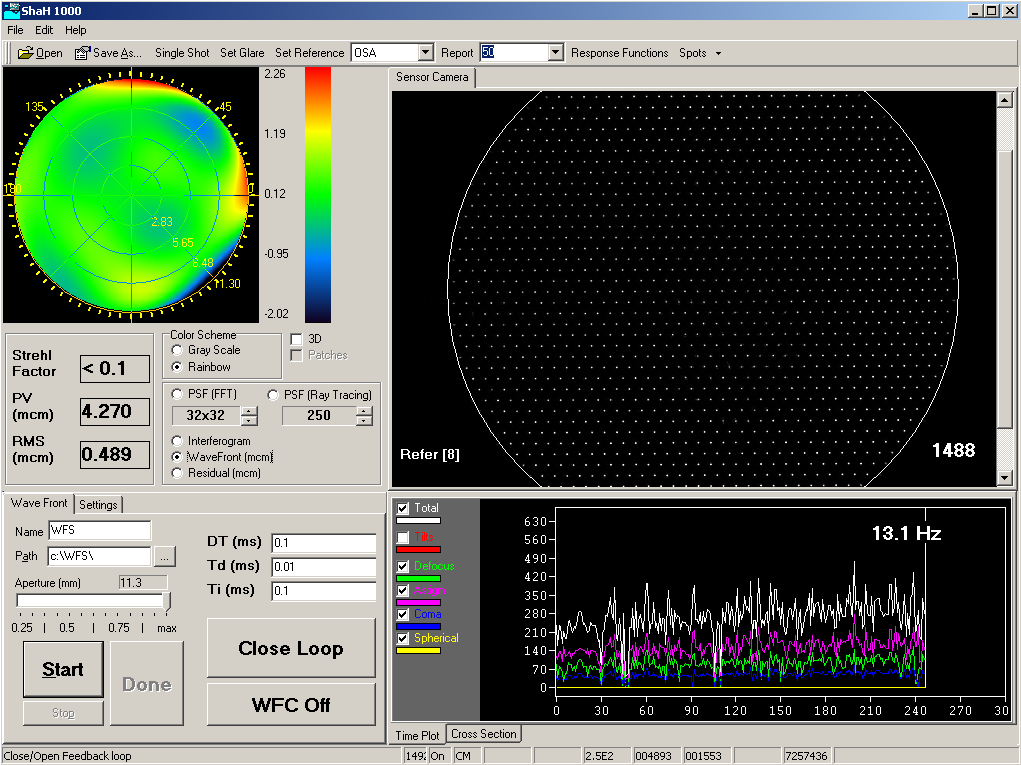
ShaH wavefront sensor software screenshot
UNIMORPH WAVEFRONT CORRECTORS
Del Mar Photonics has adopted and further developed technologies of mirror
manufacturing initially proposed in Adaptive Optics Laboratory of Lomonosov
Moscow State University. Recent advances in production technology allow us to
manufacture a variety of deformable mirrors with 30-60mm aperture diameter, good
surface quality, and record stroke for such type of the mirrors. With 30mm
aperture, the maximum measured stroke is 50um. Unlike membrane mirrors, this
type of wavefront correctors can bear an initial curvature. We have an
experience in manufacturing the mirrors with an initial radius of curvature of
500mm. The reflective surface of the mirror can be cleaned by means of a
conventional laboratory technique, which facilitates applications in university
labs. The mirrors are shock- and vibration-resistant. In comparison with bimorph
mirrors, our correctors demonstrate enhanced mechanical stability and better
reliability. The mirrors are well-suited for compensation of low order
aberrations (up to 4th order of Zernike polynomials).
Principle of operation of unimorph mirrors
The unimorph mirror itself is constructed of a thin plate of piezo-electric
material coupled to a substrate plate. The electrode pattern is deposited on the
piezo-plate, which is then joined together with the substrate to form a sandwich
structure. The ground plane is the back surface of the substrate in the unimorph.
An optical surface is formed on the front surface of the substrate plate. The
polarization of the piezo-electric plate is chosen so that to make the plate
expand or contract when voltage is applied to the electrode. The differential
expansion/contraction of the substrate and piezo-plates causes the unimorph to
bend, much in the same way as a bi-metallic strip will bend when heated.

Typical electrode arrangement diagram for standard mirrors are
shown below:
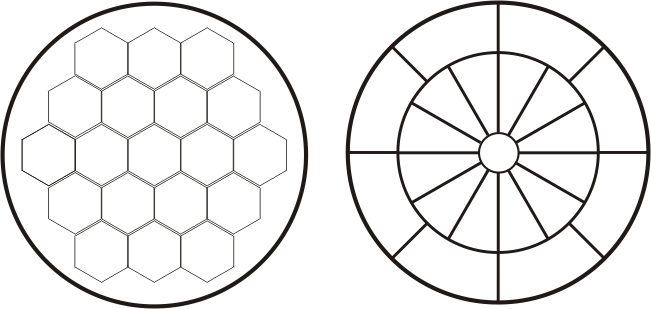
19 electrodes HEX-arrangement 21 electrodes MDL-arrangement
Typical specifications for unimorph deformable mirrors -
request a quote
Item Value
Substrate quartz, glass
Clear Aperture (diameter), mm 30-60
Stroke, μ 15-40
Number of control electrodes 13-36
Control voltage (max), V ± 300
Resonance frequency, Hz > 2000
Reflecting coatings protected Al, Ag, Cu, multilayer dielectric coating of
reflectivity ρ≥99%
Optical Damage threshold
in CW operation (up to), kW/cm²
in pulsed operation (up to), J/cm²
0.05
4
Surface quality (scratch-dig) 60-40
Hysteresis <15 %
Operating temperature range °C +10 +40
Storage temperature range °C -30 / +70
Weight (max), Kg 0.1
Size, mm Ô55x55
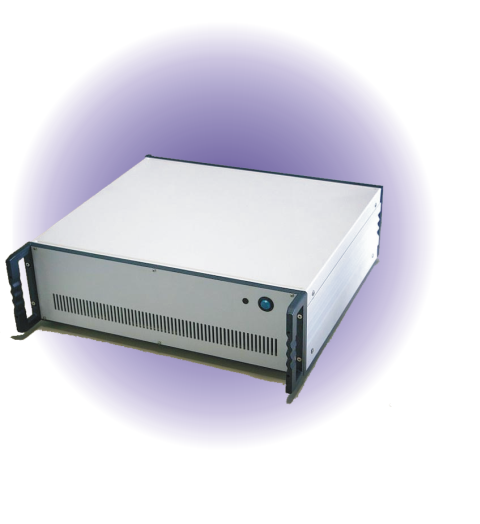 |
Control unit specification:
Item Value
Number of channels* (max) 32
Control interface USB
Response delay (max), s 0.001
Output voltages, V ± 300
Control step, V 0.15
Standard frequency bandwidth at -3dB, 100nF load, Hz > 500
Operating temperature range °C -10 / +40
Storage temperature range °C -10 / +70
Weight (max), Kg 8
Size, mm 440x400x140
(19” rack mountable)
Power supply 110-220V ; 50-60 Hz
Cable length between the amplifier and the adaptive mirror (standard), m 5
• Several units can be connected to the host computer for control mirrors with
more than 32 electrodes.
• High voltage power supply is built in.
Control Software:
• Device drivers for Windows 2000/XP, diagnostic and control utility with
graphic interface, SDK for C/C++.
Some examples of mirror response functions measured with a Twyman-Green
interferometer at λ=632.8nm, 30mm aperture:
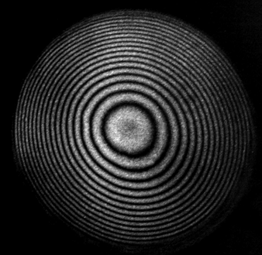 Defocus: +100V |
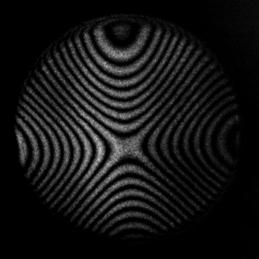 Astigmatism: +200V |
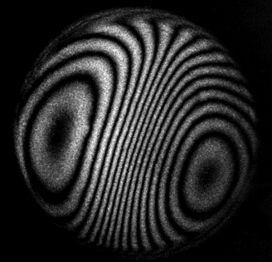 Coma: +200V |
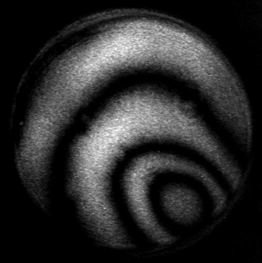 Electrode #4 (outer ring): +200V |
For larger pictures check this pages: defocus -
astigmatism - coma -
arbitrary
Del Mar Photonics - Adaptive optics (deformable mirrors) - Wavefront sensors - Complete adaptive optics system - Unimorph Deformable Mirrors part numbers
Product news and updates - Training Workshops
- Featured Customer - Other News
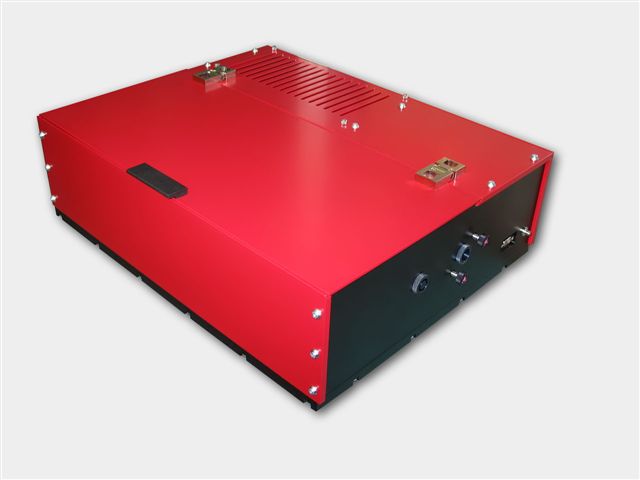 |
Trestles LH Ti:Sapphire
laser Trestles LH is a new series of high quality femtosecond Ti:Sapphire lasers for applications in scientific research, biological imaging, life sciences and precision material processing. Trestles LH includes integrated sealed, turn-key, cost-effective, diode-pumped solid-state (DPSS). Trestles LH lasers offer the most attractive pricing on the market combined with excellent performance and reliability. DPSS LH is a state-of-the-art laser designed for today’s applications. It combines superb performance and tremendous value for today’s market and has numerous advantages over all other DPSS lasers suitable for Ti:Sapphire pumping. Trestles LH can be customized to fit customer requirements and budget. Reserve a
spot in our Femtosecond lasers training
workshop in San Diego, California. Come to learn how to build a
femtosecond laser from a kit |
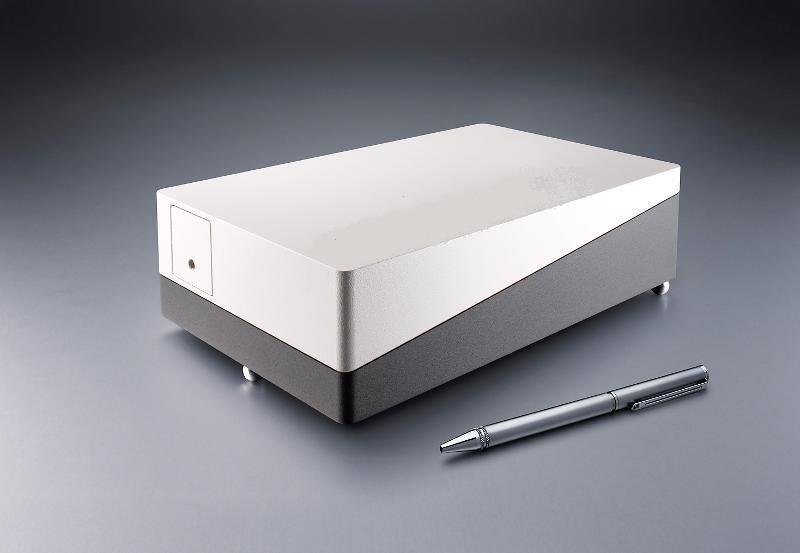 |
DPSS DMPLH lasers |
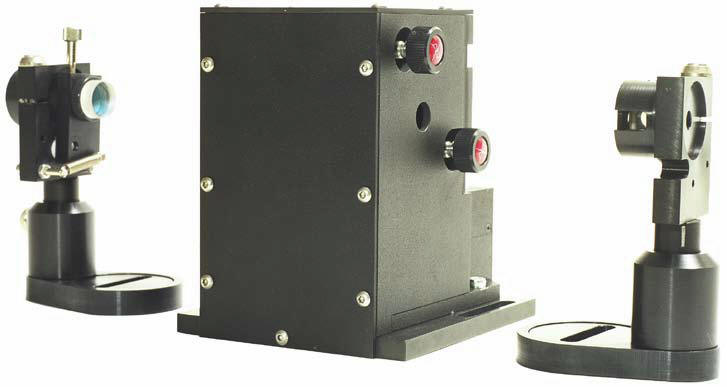 |
Pismo pulse picker The Pismo pulse picker systems is as a pulse gating system that lets single pulses or group of subsequent pulses from a femtosecond or picosecond pulse train pass through the system, and stops other radiation. The system is perfectly suitable for most commercial femtosecond oscillators and amplifiers. The system can pick either single pulses, shoot bursts (patterns of single pulses) or pick group of subsequent pulses (wider square-shaped HV pulse modification). HV pulse duration (i.e. gate open time) is 10 ns in the default Pismo 8/1 model, but can be customized from 3 to 1250 ns upon request or made variable. The frequency of the picked pulses starts with single shot to 1 kHz for the basic model, and goes up to 100 kHz for the most advanced one. The Pockels cell is supplied with a control unit that is capable of synching to the optical pulse train via a built-in photodetector unit, while electric trigger signal is also accepted. Two additional delay channels are available for synching of other equipment to the pulse picker operation. Moreover, USB connectivity and LabView-compatible drivers save a great deal of your time on storing and recalling presets, and setting up some automated experimental setups. One control unit is capable of driving of up to 3 Pockels cells, and this comes handy in complex setups or contrast-improving schemes. The system can also be modified to supply two HV pulses to one Pockels cell unit, making it a 2-channel pulse picker system. This may be essential for injection/ejection purposes when building a regenerative or multipass amplifier system. |
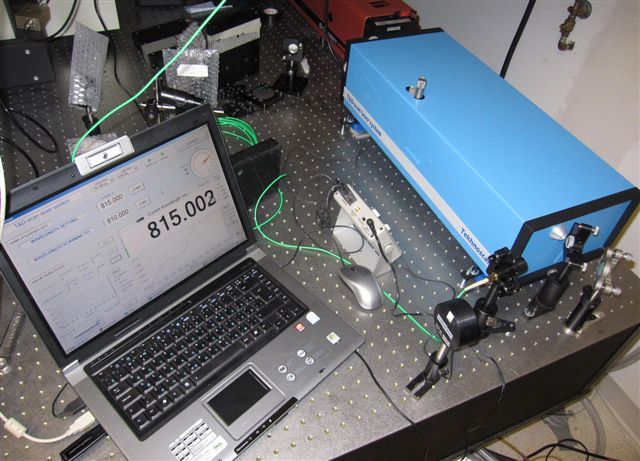 |
New laser spectrometer
T&D-scan for research that
demands high resolution and high spectral
density in UV-VIS-NIR spectral domains - now available with
new pump option! The T&D-scan includes a CW ultra-wide-tunable narrow-line laser, high-precision wavelength meter, an electronic control unit driven through USB interface as well as a software package. Novel advanced design of the fundamental laser component implements efficient intra-cavity frequency doubling as well as provides a state-of-the-art combined ultra-wide-tunable Ti:Sapphire & Dye laser capable of covering together a super-broad spectral range between 275 and 1100 nm. Wavelength selection components as well as the position of the non-linear crystal are precisely tuned by a closed-loop control system, which incorporates highly accurate wavelength meter. Reserve a
spot in our CW lasers training
workshop in San Diego, California. Come to
learn how to build a
CW
Ti:Sapphire laser from a kit |
 |
Near IR viewers Ultraviolet viewers are designed to observe radiation emitted by UV sources. |
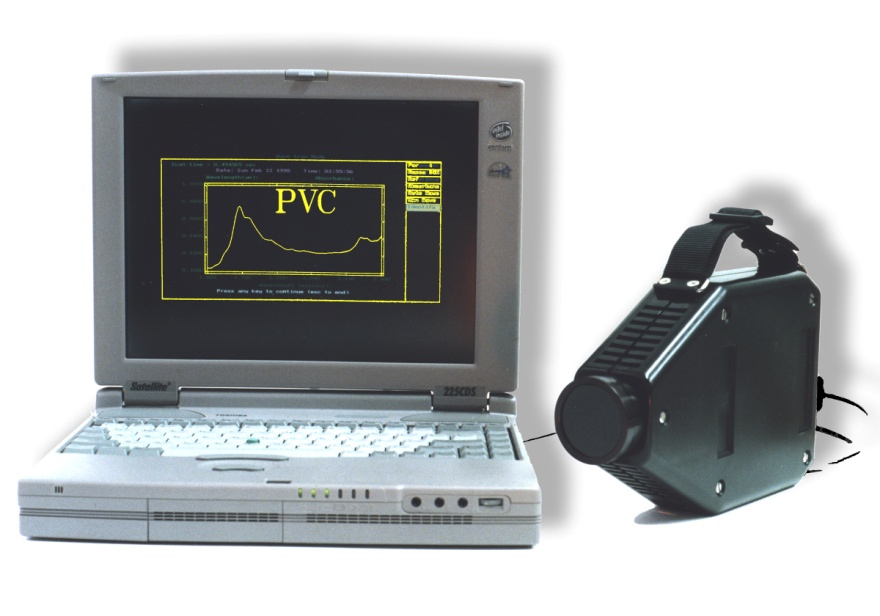 |
AOTF Infrared Spectrometer |
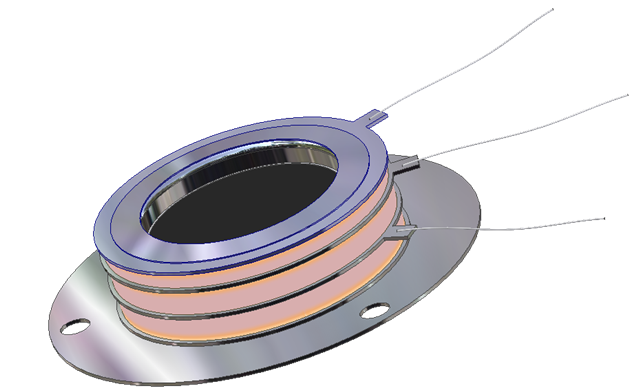 |
Open Microchannel Plate Detector
MCP-MA25/2 -
now in stock! |
 |
Hummingbird EMCCD camera The digital Hummingbird EMCCD camera combines high sensitivity, speed and high resolution. It uses Texas Instruments' 1MegaPixel Frame Transfer Impactron device which provides QE up to 65%. Hummingbird comes with a standard CameraLink output. It is the smallest and most rugged 1MP EMCCD camera in the world. It is ideally suited for any low imaging application such as hyperspectral imaging, X-ray imaging, Astronomy and low light surveillance. It is small, lightweight, low power and is therefore the ideal camera for OEM and integrators. buy online |
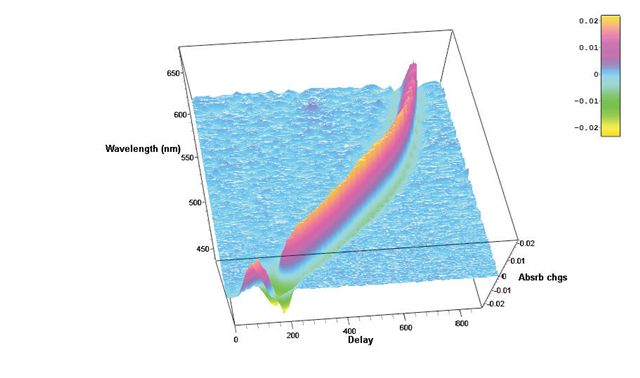 |
Hatteras-D
femtosecond transient absorption data acquisition system Future nanostructures and biological nanosystems will take advantage not only of the small dimensions of the objects but of the specific way of interaction between nano-objects. The interactions of building blocks within these nanosystems will be studied and optimized on the femtosecond time scale - says Sergey Egorov, President and CEO of Del Mar Photonics, Inc. Thus we put a lot of our efforts and resources into the development of new Ultrafast Dynamics Tools such as our Femtosecond Transient Absorption Measurements system Hatteras. Whether you want to create a new photovoltaic system that will efficiently convert photon energy in charge separation, or build a molecular complex that will dump photon energy into local heat to kill cancer cells, or create a new fluorescent probe for FRET microscopy, understanding of internal dynamics on femtosecond time scale is utterly important and requires advanced measurement techniques. Reserve a
spot in our Ultrafast Dynamics Tools
training workshop in San Diego, California. |
|
|
Beacon Femtosecond Optically Gated Fluorescence Kinetic Measurement System
-
request a quote -
pdf Reserve a
spot in our Ultrafast Dynamics Tools
training workshop in San Diego, California. |
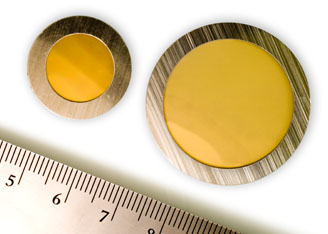 |
Terahertz systems, set ups and components New band pass and long pass THz optical filters based on porous silicon and metal mesh technologies. Band pass filters with center wavelengths from 30 THz into GHz range and transmissions up to 80% or better. Standard designs with clear aperture diameters from 12.5 to 37.5 mm. Long pass filters with standard rejection edge wavelengths from 60 THz into GHz range. Maximum transmission up to 80% or better, standard designs at 19.0 and 25.4 mm diameters. Excellent thermal (from cryogenic to 600 K) and mechanical properties THz products: THz Spectrometer kit with Antenna THz transmission setup THz time domain spectrometer Pacifica fs1060pca THz time domain spectrometer Pacifica fs780pca THz detectors: Golay cell and LiTaO3 piroelectric detectors PCA - Photoconductive Antenna as THz photomixer Pacifica THz Time Domain Spectrometer - Trestles Pacifica Holographic Fourier Transform Spectrometer for THz Region Wedge TiSapphire Multipass Amplifier System - THz pulses generation Terahertz Spectroscopic Radar Mobile System for Detection of Concealed Explosives Band pass filters with center wavelengths from 30 THz into GHz range Long pass filters with standard rejection edge wavelengths from 60 THz into GHz range Generation of THz radiation using lithium niobate Terahertz crystals (THz): ZnTe, GaAs, GaP, LiNbO3 - Wedge ZnTe |
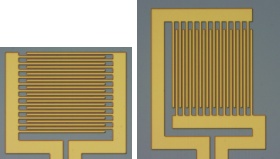 |
iPCA - interdigital Photoconductive Antenna for terahertz waves Large area broadband antenna with lens array and high emitter conversion efficiency iPCA with LT-GaAs absorber, microlens array for laser excitation wavelengths l £ 850 nm, adjusted hyperhemispherical silicon lens with a high power conversion efficiency of 0.2 mW THz power / W optical power. The iPCA can be used also as large area THz detector. The two types iPCAp and iPCAs have the same active interdigital antenna area but different contact pad directions with respect to the electrical THz field. Interdigital Photoconductive Antenna for terahertz waves generation using femtosecond Ti:Sapphire laser THz books |
 |
IntraStage lowers the cost
of test data management! Struggling with gigabytes or terabytes of test data? IntraStage easily transforms test data from disparate sources into web-based quality metrics and engineering intelligence you can use.
Contact
us today to discuss your test management requirements and specifications of your
application. |
Training Workshops
|
|
Come to San Diego next summer! Attend one of our training workshops in San Diego, California
during summer 2011 Del Mar Photonics has presented training workshops for customers and potential customers in the past 3 years. Our workshops cover scientific basics, technical details and provide generous time for hands-on training. Each workshop is a three-day seminar conducted by professional lecturer from 10am to 4pm. It includes lunch, as well as a training materials. We have also reserved two days for Q&A sessions, one-on-one system integration discussions, social networking, and San Diego sightseeing.
The following training workshops will be offered during this
summer: |
Featured Customer
|
|
Trestles LH10-fs/CW laser system at UC Santa Cruz Center of Nanoscale Optofluidics
Del
Mar Photonics offers new
Trestles fs/CW laser system which can be easily
switched from femtosecond mode to CW and back. Having both modes of operation in one system dramatically increase a
number of applications that the laser can be used for, and makes it an ideal
tool for scientific lab involved in multiple research projects. |
 |
Frequency-stabilized CW single-frequency ring Dye laser DYE-SF-007 pumped by DPSS DMPLH laser installed in the brand new group of Dr. Dajun Wang at the The Chinese University of Hong Kong. DYE-SF-077 features exceptionally narrow generation line width, which amounts to less than 100 kHz. DYE-SF-077 sets new standard for generation line width of commercial lasers. Prior to this model, the narrowest line-width of commercial dye lasers was as broad as 500 kHz - 1 MHz. It is necessary to note that the 100-kHz line-width is achieved in DYE-SF-077 without the use of an acousto-optical modulator, which, as a rule, complicates the design and introduces additional losses. A specially designed ultra-fast PZT is used for efficient suppression of radiation frequency fluctuations in a broad frequency range. DYE-SF-077 will be used in resaerch of Ultracold polar molecules, Bose-Einstein condensate and quantum degenerate Fermi gas and High resolution spectroscopy |
Other News
Optical Society of Southern California meeting at UCSD OSSC 2011-04-27
Nd:YAG laser ordered by the University of Leon, UANL, Mexico
Wedge 50 Multipass Amplifier pumped with a Darwin-527-30-M DPSS Laser
ordered by Hong Kong customer
New
Trestles LH10-fs/CW femtosecond+CW laser ready for delivery to the
University of California Santa Cruz
Trestles femtosecond
Ti:Sapphire laser delivered to North Carolina State
University
Del Mar Photonics sponsor IONS (International OSA Network of Students)
conference IONS-NA-2 in Tucson, Arizona
IONS-NA-2
website
Best talk and best
poster awards at IONS-Moscow 2010 conference sponsored by Del Mar Photonics
Watch Del Mar Photonics
videos!
Del Mar Photonics is now on Twitter!
Del Mar Photonics featured components
Del Mar Photonics continuously expands its components portfolio.
 |
Solar
Prisms for Concentrating Photovoltaic Systems (CPV) Solar cells made of compound semiconductors such as gallium arsenide are very expensive. Usually very small cells are installed and various means such as mirrors, lenses, prisms, etc..are used to concentrate sunlight on the cells. Concentration photovoltaic technology (CPV) uses the solar radiation with an efficiency of 40%, double that of conventional solar cells Del Mar Photonics design custom Concentrating Photovoltaic Systems (CPV) and supply variety of the optical components for CPV such as solar prisms shown in the picture. |
|
|
Axicon Lens Axicon lens also known as conical lens or rotationally symmetric prism is widely used in different scientific research and application. Axicon can be used to convert a parallel laser beam into a ring, to create a non diffractive Bessel beam or to focus a parallel beam into long focus depth. Del Mar Photonics supplies axicons with cone angles range from 130° to 179.5° for use with virtually any laser radiation. We manufacture and supply axicons made from BK7 glass, fused silica and other materials. download brochure - request a quote |
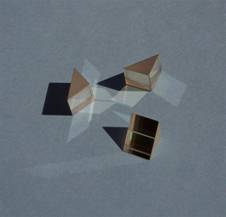 |
Rutile (TiO2) coupling
prisms Del Mar Photonics offers optical elements made of high quality synthetically grown Rutile Titanium Dioxide crystals. Rutile’s strong birefringency, wide transmission range and good mechanical properties make it suitable for fabrication of polarizing cubes, prisms and optical isolators. Boules having high optical transmission and homogeneity are grown by proprietary method. Typical boules have 10 - 15 mm in dia. and up to 25 mm length. Optical elements sizes - from 2 x 2 x 1 mm to 12.7 x 12.7 x 12.7 mm. Laser grade polish quality is available for finished elements. So far we the largest elements that we manufactured are 12 x15 x 5 mm, in which optical axis is parallel to 15 mm edge, 5 mm is along beam path, 12 x 15 mm faces polished 20/10 S/D, one wave flatness, parallelism < 3 arc.min. (better specs. available on request). more details - download brochure - request a quote |
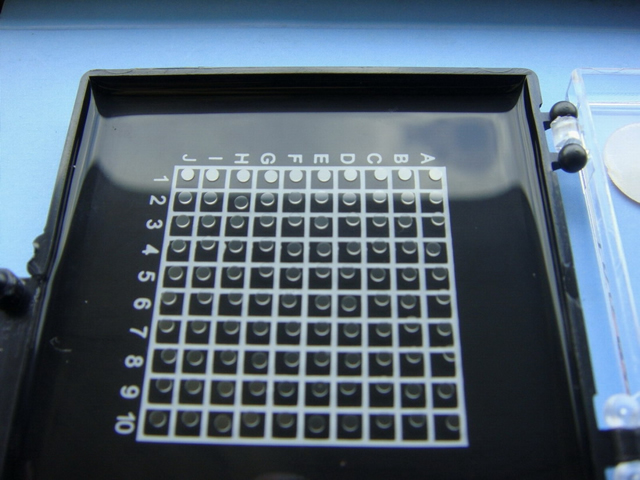 |
Sapphire components Sapphire Circular Windows - Square & Rectangle - Rods Sapphire & Ruby Rings - Sapphire & Ruby Balls - Sapphire & Ruby Nozzles Sapphire Lenses - Ball & Seat - Special Products - Sapphire Vee & Cup Jewels Sapphire Ceramics - Ceramic Sleeves - Ceramic Holes - Ceramic Rods Sapphire & Ruby Orifices - Sapphire & Ruby Tubes - Sapphire Components Sapphire Half Round Rod - Sapphire Windows - Rods & Tubes - Special Part Sapphire Prism - Sapphire Chisel - Sapphire Square Rod |
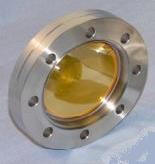 |
Vacuum viewport Del Mar Photonics offer a range of competitively priced UHV viewports , Conflat, ISO or KF including a variety of coatings to enhance performance. Del Mar Photonics viewports are manufactured using advanced techniques for control of special and critical processes, including 100 percent helium leak testing and x-ray measurements for metallization control. Windows Materials include: Fused silica, Quartz , Sapphire , MgF2, BaF2, CaF2, ZnSe, ZnS, Ge, Si, Pyrex. Standard Viewing diameters from .55" to 1.94 ". Coating - a range of custom coatings can applied - which include - Single QWOT - Broad Band AR - V coatings - ITO - DLC (Diamond like coating) more details - request a quote |
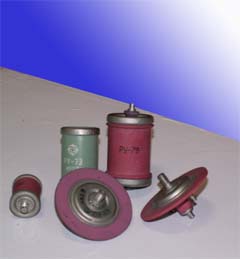
|
Hydrogen
Thyratrons are used in
such devices as radars with different power levels, high-power pulsed
technical, electrophysical, medical devices and lasers. Sophisticated
design and high quality ceramic-metal envelope determines long lifetime
and very accurate and reliable operation of hydrogen thyratrons under wide range of environmental
conditions. Applications: - radars - pulsed lasers power supplies - medical apparatus - electrophysical instrumentation Triggered Three-Electrode Spark Gap Switches are ceramic-metal sealed off gas discharge trigatron-type devices with a co-axial trigger electrode. These Gas Discharge Tubes contain no mercury and, due to an advanced design, feature high reliability and a long lifetime being operating under wide range of environmental conditions. Applications: - pulsed installation for processing materials - installations with plasma focus - pulse power supplies for lasers and other pulse equipment - medical apparatus such as lithotriptors and defibrillators - processing systems for petroleum wells |
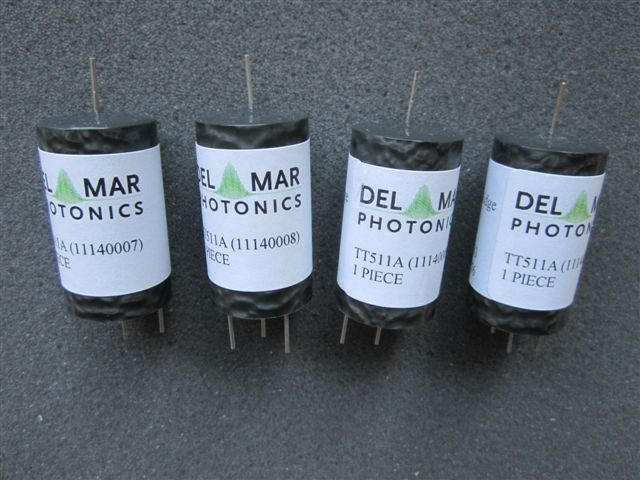 |
Trigger Transformers Del Mar Photonics supply trigger transformers for triggered spark gaps and other applications. Contact us to today to discuss your application or requesta quote. Trigger Transformers are used to provide a fast high voltage pulse up to 30kV/µs and more. This high voltage pulse is applied to the trigger electrode to initiate switching action in the three-electrode spark gaps. Either positive or negative pulses can be obtained from all of the transformers.
|
 |
We are looking forward to hear from you and help you with your optical and crystal components requirements. Need time to think about it? Drop us a line and we'll send you beautiful Del Mar Photonics mug (or two) so you can have a tea party with your colleagues and discuss your potential needs. |
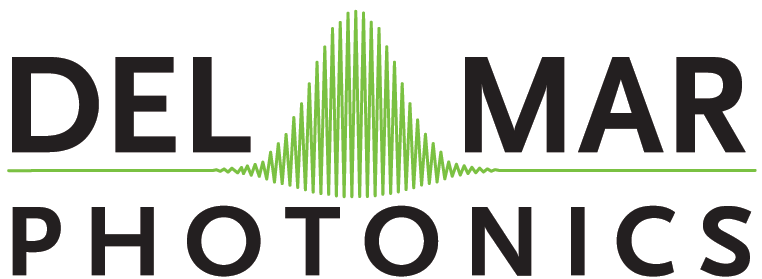
Del Mar Photonics, Inc.
4119 Twilight Ridge
San Diego, CA 92130
tel: (858) 876-3133
fax: (858) 630-2376
Skype: delmarphotonics
sales@dmphotonics.com